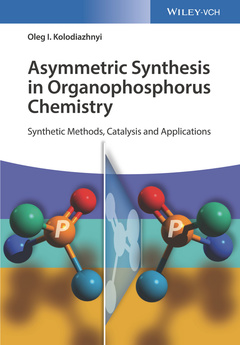Asymmetric Synthesis in Organophosphorus Chemistry Synthetic Methods, Catalysis, and Applications
Auteur : Kolodiazhnyi Oleg I.

As such, this unique reference covers the chemical background as well as spectroscopical analysis of phosphorus compounds, and thoroughly describes all the various synthetic strategies for these substances. Metal-, organo- and biocatalyzed reactions for the introduction of phosphorus are explained as are asymmetric oxidation and reduction methods for the preparation of all possible oxidation states of phosphorus. The text also includes industrial applications for these compounds.
Of particular interest to chemists working in the field of asymmetric synthesis, as well as to the pharmaceutical industry due to the increasing number of phosphorous-containing drugs.
Preface xi
Abbreviations xiii
1 Fundamentals of the Stereochemistry of Organophosphorus Compounds 1
1.1 Historical Background 1
1.2 Some Common Definitions in Stereochemistry 4
1.3 Determination of Enantiomer Composition 7
1.3.1 Method of Nuclear Magnetic Resonance 8
1.3.1.1 Chiral Solvating Agents 8
1.3.1.2 Complexes of Metals (Shift Reagents) 10
1.3.1.3 Chiral Derivatizing Agents for NMR 11
1.3.2 Chromatographic Methods of Analysis 14
1.3.2.1 Gas Chromatography 15
1.3.2.2 Liquid Chromatography 16
1.4 Determination of the Absolute Configuration 17
1.4.1 X-ray Crystal Analysis 17
1.4.2 Method of Chemical Correlation 19
1.4.3 The Assignment of Absolute Configuration by NMR 19
1.5 Asymmetric Induction and Stereochemistry 24
1.5.1 Asymmetric Induction 24
1.5.2 Asymmetric Synthesis 25
1.5.3 Asymmetric Transformation 25
1.5.4 An Enantioselective Reaction 25
1.5.5 Enantioselective Synthesis 25
1.6 Summary 26
References 26
2 Asymmetric Synthesis of P-Chirogenic Phosphorus Compounds 35
2.1 Introduction 35
2.2 Low-Coordinated Phosphorus Compounds 36
2.3 Trivalent Tricoordinated Phosphorus Compounds 41
2.3.1 Configuration Stability of P(III)-Compounds 41
2.3.2 Asymmetric Nucleophilic Substitution at P (III) 43
2.3.2.1 Secondary Alcohols as Chiral Auxiliaries 45
2.3.2.2 Optically Active Amines as Chiral Auxiliaries 54
2.3.2.3 Ephedrine as Inductor of Chirality at P(III) 58
2.3.3 Asymmetric Oxidation of P(III) Compounds 67
2.3.4 Asymmetric Electrophilic Substitution at P(III) 68
2.3.4.1 Asymmetric Michaelis–Arbuzov Reaction 70
2.4 Pentavalent P(IV)-Phosphorus Compounds 71
2.4.1 Introduction 71
2.4.2 Nucleophilic Substitution Reactions 72
2.4.2.1 Nucleophilic Substitution at P(IV) with Chiral Alcohol 74
2.4.2.2 Nucleophilic Substitution at P(IV) with Chiral Amines 78
2.5 Chiral P(V) and P(VI) Phosphorus Compounds 80
2.6 Summary 86
References 87
3 Phosphorus Compounds with Chiral Side-Chain Centers 101
3.1 Introduction 101
3.2 Asymmetric Induction in Side Chains 102
3.2.1 Transfer of Chirality from Phosphorus to Other Centers 103
3.2.1.1 Chiral Phosphorus-Stabilized Anions 103
3.2.1.2 1,2-Asymmetric Induction 105
3.2.1.3 1,4-Asymmetric Induction 107
3.3 Enantioselective Olefination 113
3.4 Stereoselective Addition of Phosphorous Nucleophiles to C=X Bonds 117
3.4.1 Phospha-Aldol Reaction 119
3.4.2 Phospha-Mannich Reaction 130
3.4.3 Phospha-Michael Reaction 142
3.5 Asymmetric Reduction 147
3.6 Asymmetric Oxidation 152
3.7 C-Modification 156
3.8 Asymmetric Cycloaddition 157
3.9 Multiple Stereoselectivity 159
3.10 Summary 169
References 170
4 Asymmetric Catalysis with Metal Complexes 187
4.1 Introduction 187
4.2 Asymmetric Catalytic Hydrogenation and Other Reactions of Reduction 188
4.2.1 Hydrogenation of C=C Phosphorus Compounds 188
4.2.2 Hydrogenation of C=O Phosphorus Compounds 200
4.3 Asymmetric Reduction and Oxidation 203
4.3.1 Reduction of C=O, C=N, and C=C bonds 204
4.3.2 Asymmetric Oxidation 210
4.4 Electrophilic Asymmetric Catalysis 211
4.4.1 Catalytic Electrophilic Substitution at the Phosphorus Atom 212
4.4.1.1 Alkylation and Arylation of P(III) Compounds 213
4.4.2 Catalytic Electrophilic Substitution in a Side Chain 217
4.4.2.1 Alkylation 217
4.4.2.2 Halogenation 219
4.4.2.3 Amination 221
4.5 Nucleophilic Asymmetric Catalysis 223
4.5.1 Asymmetric Addition of Phosphorus Nucleophiles to Multiple Bonds 223
4.5.1.1 Phospha-Aldol Reaction 224
4.5.1.2 Phospha-Mannich Reaction 229
4.5.1.3 Phospha-Michael Reaction 232
4.6 Cycloaddition Reactions 237
4.7 Summary 240
References 241
5 Asymmetric Organocatalysis 253
5.1 Introduction 253
5.2 Modes for Catalytic Activation of Substrates in Asymmetric Organocatalysis 254
5.3 Phospha-Aldol Reaction 258
5.3.1 Catalysis with Cinchona Alkaloids 258
5.3.2 Catalysis with Cinchona-Thiourea 259
5.3.3 Catalysis by Other Organocatalysts 260
5.4 Phospha-Mannich Reactions 262
5.4.1 Organocatalysis by Cinchona Alkaloids 262
5.4.2 Organocatalysis by Imines 263
5.4.3 Organocatalysis by Iminium salts 265
5.4.4 Organocatalysis by Chiral Brønsted acids 265
5.5 Phospha-Michael Reaction 269
5.5.1 Organocatalysis by Cinchona Alkaloids 269
5.5.2 Organocatalysis by Thiourea 270
5.5.3 Organocatalysis by Iminium salts 272
5.5.4 Organocatalysis by N-Heterocyclic Carbenes 274
5.5.5 Organocatalysis Using Proline Derivatives 274
5.6 Organocatalytic Addition to Ketophosphonates 282
5.6.1 Proline, Amino Acids, andTheir Derivatives 282
5.6.2 Organocatalysis by Thiourea 288
5.7 Phospha-Henry Reaction 288
5.8 OrganocatalyticModification of P-ylids 290
5.9 Asymmetric Catalysis with Chiral Diamines 292
5.10 Miscellaneous 303
References 305
6 Asymmetric Biocatalysis 315
6.1 Introduction 315
6.2 Enzymatic Synthesis of Organophosphorus Compounds 315
6.2.1 Kinetic Resolution of Hydroxyphosphonates 316
6.2.2 Resolution of α-Hydroxyphosphonates by Biocatalytic Transesterification 317
6.2.3 Resolution of α-Hydroxyphosphonates by Biocatalytic Hydrolysis 319
6.2.4 Dynamic Kinetic Resolution of α-Hydroxyphosphonates 323
6.2.5 Resolution of β- and ω-Hydroxyphosphonates 323
6.2.6 Dynamic Kinetic Resolution of β-Hydroxyphosphonates 331
6.2.7 Resolution of Aminophosphonates 332
6.3 Biosynthesis of Compounds with C–P Bond 335
6.4 Resolution of P-Chiral Phosphorus Compounds 337
6.5 Microbiological Synthesis of Chiral Organophosphorus Compounds 349
6.5.1 Yeast-Catalyzed Synthesis 349
6.5.2 Synthesis Using Unicellular Fungi 354
6.5.3 Synthesis Using Bacteria 356
6.6 Summary 358
References 358
Index 369
His current interest is chemistry of organophosphorus compounds, highly reactive phosphorus compounds and reagents. Over the last years, Kolodiazhnyi has been studying the asymmetric synthesis, stereochemistry of organophosphorus compounds and synthesis of biologically active compounds. He is author of >500 publications and 28 patents, including three monographs, a number of reviews and chapters. He is currently member of the editorial boards of the "Journal of Phosphorus, Sulfur, Silicon and Related Elements (USA)" and member of editorial board of "Russian Journal of General Chemistry" (St. Petersburg). In 2014 he was awarded by State Premium of Ukraine in Science and Technology for eminent achievements in Organophosphorus chemistry. He is also prize-winner of the Kiprianov Premium on Organic Chemistry of Ukrainian Academy of Science and numerous other scientific awards.
Date de parution : 12-2016
Ouvrage de 392 p.
17.5x24.9 cm
Thème d’Asymmetric Synthesis in Organophosphorus Chemistry :
Mots-clés :
organophosphorus



